Financial markets of US
Aspirants who want in-depth exposure to global and country-specific capital markets opt for Assignments in financial markets. These Assignments generally cover capital market products – both listed and OTC, capital market operations, asset management, mutual funds, product control and risk management and stock market indexes. Focus is also laid on the introduction to risk management and behavioural principles of finance to understand the real-world functioning of securities, insurance, and banking industries. This article is entirely focused on providing you an overview of financial markets of the world’s leading nation- The United States. If you have any queries regarding financial markets including primary and secondary markets, commodities, derivatives, exchanges and indices, you can contact assignmenthelp.net. As soon as you contact us, one of our finance experts will get in touch with you to solve all your queries.
In finance, the financial market encompasses a part of the independent market economic system within which individuals and entities trade securities, commodities and other goods that replicate their supply and demand. The financial markets facilitate a variety of things that are significant for the working of a market economy, an economy that is heavily dependent on interactions between buyers and sellers for the efficient allocation of its resources.
Indexes play a vital role in the overall analysis of the U.S. equity market. Indexes and their movements help in gaining a complete insight of the economy, the risk appetite of the investors, and the trends which are useful for diversifying investments. To put it simply, understanding the nuances of indexes, their construction and composition are essential for making all kinds of investment choices.
- S. FINANCIAL MARKETS
The U.S financial market is one of the largest markets in the world offering a diverse range of products like fixed-income securities, equities, stocks, bonds, foreign exchange currencies and derivatives on a number of trading platforms and exchanges.
New York Stock Exchange (NYSE) trades in trillion dollars of securities on a daily basis.
FINANCIAL SECURITIES MARKETS IN U.S.
The following is the main financial securities markets in the U.S.:
- NYSE- New York Stock Exchange:
NYSE is based in New York. There was a merger of the New York Stock Exchange and European stock exchange known as Euronext in April 2007, to form the currently known NYSE Euronext. Also, NYSE Euronext owns NYSE Arca, which was formerly called the Pacific Exchange.
Additional Stock Exchanges in the United States are
- Boston Stock Exchange (BSE) – It is a merger of the Boston Equities Exchange (BEX) and the Boston Options Exchange (BOX). Later in 2007, BSE was acquired by NASDAQ.
- Chicago Board Options Exchange (CBOE)
- Chicago Board of Trade (CBOT) – It is owned and controlled by CME Group Inc.
- Chicago Mercantile Exchange (CME) – It is owned and run by CME Group Inc.
- Chicago Stock Exchange (CHX)
- International Securities Exchange (ISE) - ISE Options Exchange and the ISE Stock Exchange are included in it.
- Miami Stock Exchange (MS4X)
- National Stock Exchange (NSX)
- Philadelphia Stock Exchange (PHLX)
You can chat with us on assignmenthelp.net if you want more detail of the above-mentioned stock exchanges.
The Financial Services Industry in the United States
OVERVIEW
The largest and most liquid financial markets belong to the United States. The U.S. is the global leader in the finance and insurance sector lays down the way to create a stupendous number of direct and indirect jobs in the nation. The finance and insurance sector represents $1.5 trillion i.e. 7.4 % of the total GDP of the U.S.
According to the records of United States exports, financial services and insurance worth $114.5 billion were exported in 2017 and the country had a surplus of $40.8 billion of the same. These financial services facilitate the export of agricultural products and manufactured goods of the U.S and thus, it creates enormous employment opportunities- More than 6.3 million people were employed in this sector at the end of 2018.
Financial firms gain significant advantages by investing in U.S. financial services. As the financial services sector of United States is creative, competitive, and comprehensive, around 30 companies which are engaged in financial services, out of all companies in Fortune's Global 500 listing of 2018, have located their headquarters in the United States. Consumers can manage risk, create wealth and meet their financial needs by choosing from the wide array of instruments and products offered by this industry.
Contact us on assignmenthelp.net if you need help with essay writing on global financial markets or financial markets of U.S. You can undoubtedly score excellent grades with our essay writing help service.
SUB-SECTORS OF FINANCIAL SERVICES INDUSTRY OF U.S.
- Banking:
- $17.9 trillion of assets and a net income of $236.8 billion was held by the U.S. banking system by the end of 2018.
- This sector has the world’s greatest diversity in banking institutions and the concentration of private credit.
- The asset and loan growth in the U.S. commercial banking sector is going to remain constants for the next couple of years- as expected by Fitch Solutions.
PRIMARY CREDIT RATE IN THE UNITED STATES FROM 2003 TO 2018
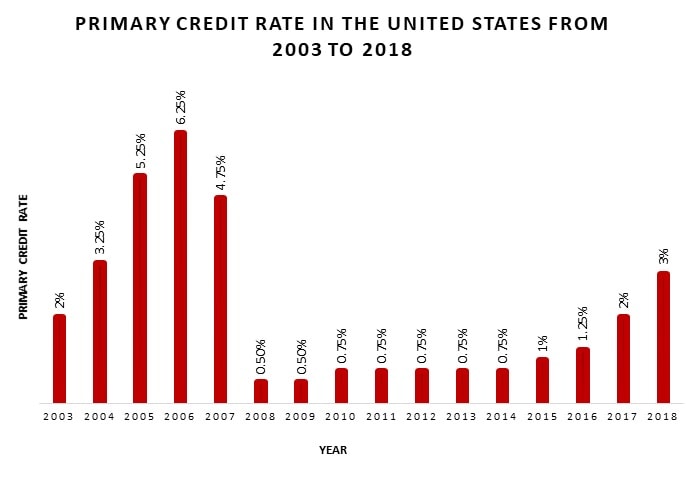
The above bar graph shows the improvement in the rate of primary credit in the United States from 2003 to 2018. The primary credit rate represents the rate at which central banks provide loans to financial institutions for a short period of time. The primary credit in the United States rate was 3% in the year 2018.
Federal funds rate level: RATE IN THE UNITED STATES FROM 2007 TO 2018
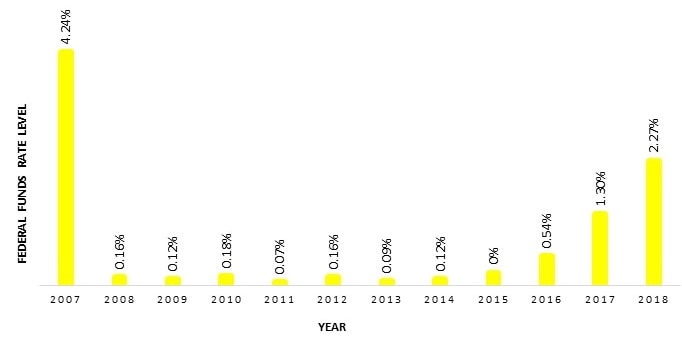
There was a rise in the federal funds rate from 0.2% during the unprecedented time of financial crisis to 2.27 percent in 2018. The federal funds rate refers to the interest rate from the Federal Reserve, which is the central bank of the United States. It is a very significant financial indicator and analysts all across the world refer to this rate.
Average daily trading volume of U.S. treasury securities 2000-2017
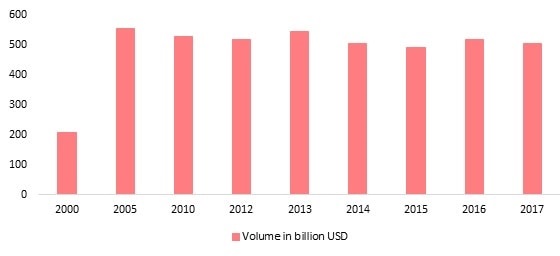
In 2017, the average net volume of treasury securities traded per day was more than 505 billion U.S.D. This shows that every day the market was open, the average amount of transactions in U.S. government securities amounted to half a trillion U.S. dollars of that very year.
Total debt securities of household sector in the United States from 2000 to 2017 (in billion U.S. dollars)
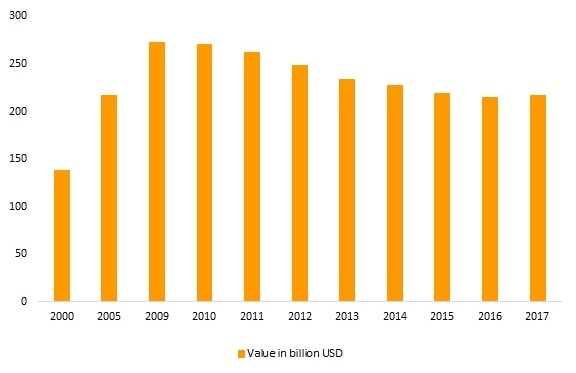
The above statistic shows data of the net debt securities of the U.S. household sector from 2000 to 2017. In 2017, the household sector of the U.S. had total debt security of 217 billion U.S.D.
Total debt securities of domestic nonfinancial sector in the United States from 2000 to 2017 (in trillion U.S. dollars)
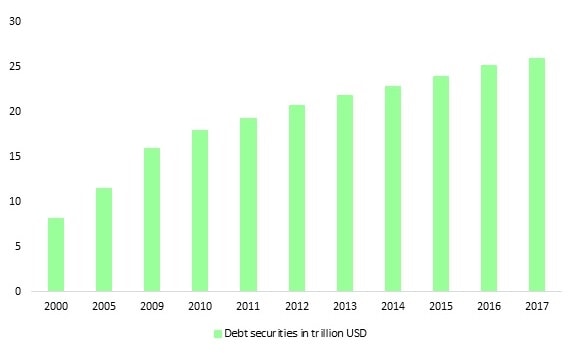
This above statistical representation shows the total debt securities of the domestic non-financial sector of the U.S. from 2000 to 2017. In 2017, the total debt securities of the domestic non-financial sector of the United States amounted to approximately 25.9 trillion U.S. dollars.
- Asset Management:
- By the end of 2017, the total U.S. retirement assets were approximated to be @28.2 trillion.
- If we add insurance assets and mutual funds, the long-term conventional assets under management in the U.S. would amount to $51 trillion, as of 2016.
- The U.S. asset management subsector has made its depth globally and it has no rivals standing close to it.
- Over 60% of pension management needs of global retirement market is met by this particular sector.
Total net assets of US-registered mutual funds worldwide from 1998 to 2018 (in trillion U.S. dollars)
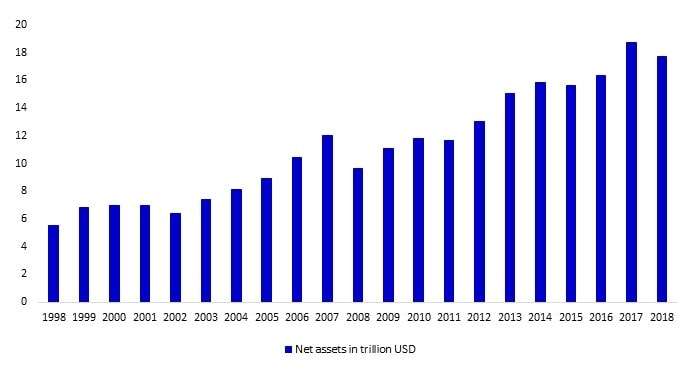
The statistical data above presents the net assets of US-registered mutual funds worldwide from 1998 to 2018. The records of 2018 show that the net global net assets of mutual funds registered in the United States were approximately 17.71 trillion U.S. dollars.
- Insurance:
- In 2016, a total of $1.1 trillion was collected as premiums by the insurance industry of the U.S.
- As shown by the data of NAIC, 53% of the premium were received from life and health insurers and the remaining 43% were received by property and casualty insurers.
- S. insurance companies actively receive propositions for business partnerships and collaborations from international insurance companies.
- Top boot, around one-third of net reinsurance sold across the world is bought by U.S. insurance firms.
- Venture Capital:
- Several of the world’s most innovative firms are supported by the global venture capital (VC) industry of the United States.
- 2017 recorded a 16% increase in Venture capital investments as compared to that of 2016.
- Investment in more than 8000 different deals amounted to $84 million was an investment in the U.S. VC industry.
- It was the highest amount since the early 2000s. 82% workforce of private-sector research and development and 38% workforce of public American companies are employed in the companies backed by Venture capital.
- According to Stanford University and NVCA, these companies have traditionally generated revenue equal to 21%.
Direct investment position of the U.S. abroad 2000-2017
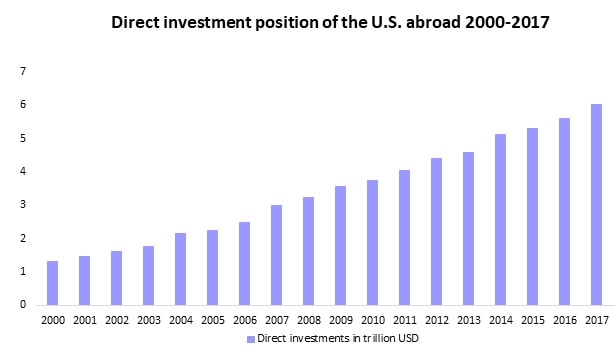
In 2017, FDI from the U.S. to other countries of the world amounted to 6.01 trillion U.S. dollars. The foreign direct investment shows the ownership in a company or an organisation of one country located in another country. It differs from a traditional investment in companies located abroad by the ownership factor in case of Foreign direct investment.
Countries with highest foreign direct investment (FDI) position in the United States in 2017 (in billion U.S. dollars, on a historical-cost basis)
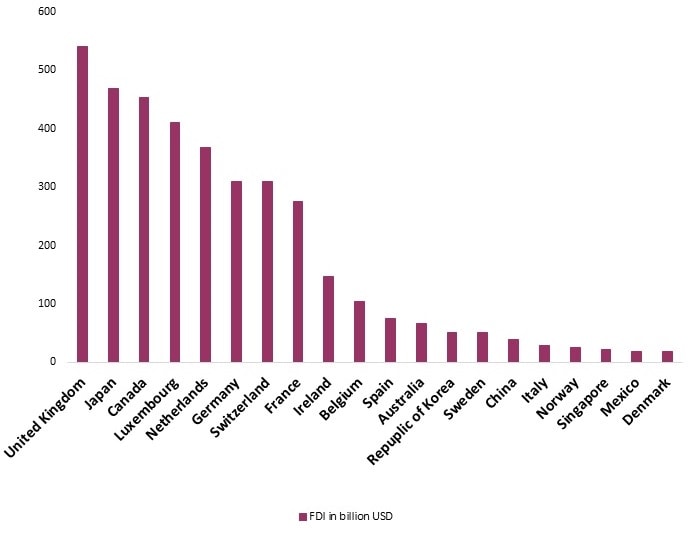
In 2017, none of the countries had a higher FDI position in the United States than the United Kingdom. It was followed by Japan and Canada. During that time, the UK had over 540 billion U.S. dollars invested in the U.S.
- Private Equity:
- As of 2017, private equity firms of the United States have made an investment of more than $500 billion in companies based in the U.S.
- Nearly 4,700 investment firms that are operational in all 50 states of the U.S. belong to the private equity industry of the United States.
- 3 million people in the United States and 19.6 million people worldwide are employed in the 30,000 private U.S. companies which are backed by U.S. private equity firms.
- A bulk of U.S. private equity investment was attracted to the business services and consumer-related businesses.
STOCK MARKET INDEXES OF THE U.S.
- Both the global economy and country-specific economy across the world consider stock market indexes to be a powerful indicator of ascertaining growth and development.
- Both media and investors round the world and especially in the United States, follow the following major indexes:
- S&P 500
- NASDAQ Composite
- Apart from the above, there are around 5000 more indexes that frame the overall U.S. equity market. These indexes serve a broad range of purposes to the wide range of methodologies and categorizations of the United States financial market.
- Very frequent reports are provided by media regarding the top three performing indexes along with the news items that serve as detractors and contributors. These indexes are used as benchmarks by investment managers who report the performances of companies.
- In the meantime, investors of all kinds, use these indexes as a guide for allocation and performance proxy. Passive index investors trade in exchange-traded funds that track indexes in particular.
- A wide variety of investment avenues can be well understood with a thorough understanding of how market indexes are constructed and used.
Following is an elaboration of the three most followed U.S. indexes:
- The S&P 500
- 500 top companies in the U.S. Stocks are chosen in The Standard & Poor's 500 Index (also known as the S&P 500). The selection is primarily based on capitalization but other factors like liquidity, public float, sector classification, financial viability, and trading history are also taken into account by the constituent committee.
- Approximately 80% of the total value of the U.S. stock market is represented by the S&P 500 Index. A reliable indication of overall movement in the U.S. market is provided by the S&P 500 Index.
- All the indexes are either market-weighted or price-weighted. As in the case of the S&P 500 Index, it is a market-weighted index, also commonly referred to as capitalization -weighted. Hence, each stock in the index is expressed in proportion to its overall market capitalization.
- Say, for instance, if the total market value of all 500 companies in the S&P 500 decreases by 10%, the value of the index will also decrease by 10%.
- The Dow Jones Industrial Average
- DJIA- Dow Jones Industrial Average is one of the oldest, extremely popular, and most frequently used indexes in the world. Stocks of 30 of the biggest and most prestigious companies in the United States are included in this index.
- The original computation was done by adding up the per-share price of the stocks of every company in the index and dividing the net total so arrived by the number of companies. Sadly, the computation done these days aren’t this straightforward any longer.
- As there have been numerous stock splits, spin-offs, and other events in the companies, the divisor computed by Dow Jones which is used to calculate the level of the DJIA, has become an extremely tiny number- less than 0.2.
- Although the DJIA represents almost a quarter of the worth of the entire securities market of the U.S., because of the Dow's price-weighted function, it won’t be right to interpret a percentage change in Dow as a specific indication that the whole market has decreased by an equivalent percentage.
- Let’s try the understand the basic problem that lies here, a $1 change in the price of a stock worth $120 in the index will have a larger impact on the Dow Jones Industrial Average as compared to a $1 change in the price of a stock worth $20, even though the stock with higher price may have changed by just 0.8% and the other by 5%.
- A shift in the Dow will change the expectations of the investors regarding their earnings and the risks they have undertaken with respect to the large companies which are a part of the index.
- The Dow cannot be used to represent sentiment related to small-cap stocks of the marketplace., as the general perspective towards large-cap stocks often typically differs from the attitude toward small-cap stocks, international stocks, or technology stocks. In general context, the Dow is popular for its listing of the best blue-chip companies of U.S. markets which have consistently been regular in paying dividends.
- Hence, it isn’t necessarily a representation of the overall market but it can certainly be considered as a representation of the dividend-valued blue-chip market.
Monthly development of the Dow Jones Industrial Average index from June 2017 to June 2019
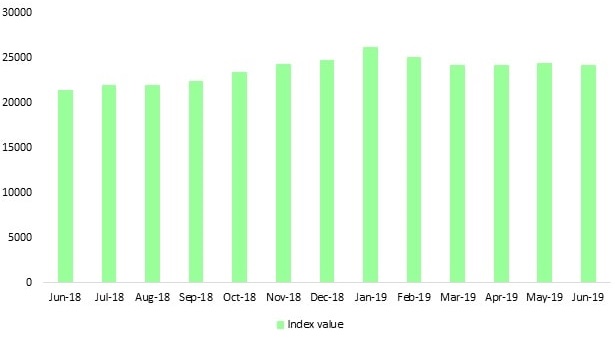
The statistical data represented above shows the monthly development of the Dow Jones Industrial Average index from June 2017 to June 2019. On June 28, 2019, the value of the DJIA index amounted to 26,599.96.
- The NASDAQ Composite Index
- The exchange on which technology stocks are traded is known as the National Association of Securities Dealers Automated Quotations- NASDAQ. The market-capitalization-weighted index of all the stocks listed on the NASDAQ stock exchange is represented by the Nasdaq Composite Index. Some of the companies based out of the United States are also included in the index.
- It is primarily known for being heavily technology weighted, as such, it includes many subsectors of tech market- software, biotech, semiconductors, and more.
- Even though this index is mainly known for its huge part of technology stocks, it does embody few stocks of other industries as well. Stocks from financial, industrial, insurance and transportation sectors can also be found by investors in this index.
- NASDAQ is a composite of several big and small companies, however, in contrast to the S&P 500 and also the Dow, it is also inclusive of many speculative companies that have a little market capitalization. Therefore, the movement of the NASDAQ index usually is considered to be an indicator of how well the technology industry is performing and what attitude the investors are having towards the speculative stocks.
Value of the NASDAQ Industrial Index from 2010 to 2017
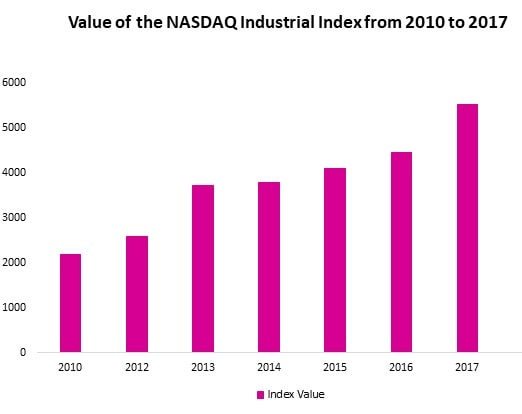
This bar graph above presents the year-end closing values of the NASDAQ industrial index from 2010 to 2017. In 2017, the value of the NASDAQ industrial Index amounted to 5,514 points.
- The Wilshire 5000
- The Wilshire 5000, finalized in 1974,is often called by two other names which are:
- Total stock market index
- Total market index
- It is named so because it is inclusive of all the publicly traded firms that have their headquarters registered in the United States and have ready-made price data.
- The aggregate movement of the entire U.S. stock market is represented by the Wilshire 5000.
- Even though the Wilshire 5000 is a very comprehensive measure of the overall U.S. financial market, it is not referred by investors as much as the very popular S&P 500 Index is referred.
- Other Indexes of the U.S.
- Generally, there aren’t many ways to view indexes on a broad basis. AS the indexes fall into either large-cap, mid-cap, or small-cap brackets, they are usually based on Capitalization. The top large-cap indexes include only &P 500 and Dow Jones Industrial Average. There are several other indexes like- the S&P 100, the Dow Jones U.S., the MSCI USA Large-Cap Index, the Russell 1000, and Large-Cap Total Stock Market Index the Russell 1000.
- S&P Mid-Cap 400, the Russell Midcap, and the Wilshire US Mid-Cap Index are some of the notable mid-cap indexes.
- The 2,000 smallest stocks from the Russell 3000 is represented by Russell 2000 which is a small-cap index.
- The S&P 600, the Dow Jones Small-Cap Growth Total Stock Market Index, and the Dow Jones Small-Cap Value Total Stock Market Index are some of the other famous small-cap indexes.
- In this realm of the market investors generally look at sectors with Standard & Poor’s leading.
Standard & Poor’s caters to the management of the following:
- S&P Communication Services Select Sector
- S&P Consumer Discretionary Select Sector
- S&P Consumer Staples Select Sector
- S&P Energy Select Sector
- S&P Financial Select Sector
- S&P Health Care Select Sector
- S&P Industrial Select Sector
- S&P Materials Select Sector
- S&P Real Estate Select Sector
- S&P Technology Select Sector
- S&P Utilities Select Sector
The above indexes represent the comprehensive sector division of the S&P 500.
- The evolvement of smart beta index investing has facilitated the increase in the number of indexes present in the market.
- Wondering what Smart beta index is?
The passive indexes that are built by applying specific features or basic fundamental screens which help in the improvement of the quality of the index constitution is called smart beta index.
- The whole global market for dividend and value investing is encompassed by three smart beta index funds which are held by Advisors Asset Management (AAM).
The following are the smart beta index funds of AAM
- AAM S&P Emerging Markets High Dividend Value ETF (EEMD)
- AAM S&P Developed Markets High Dividend Value ETF (DMDV)
- AAM S&P 500 High Dividend Value ETF (SPDV)
We hope that we were able to provide you a thorough explanation of the basics of financial markets with a focus on markets of the United States, the stock indices, their construction and usage. In case you have any queries regarding any topics that we have discussed, please feel free to reach out to us by contacting our finance experts at assignmnethelp.net. We also provide top-notch research reports and thesis on numerous topics; you can contact us by sitting at the comfort of your home to enjoy a seamless Assignment Help service. We will be extremely delighted to serve you!
